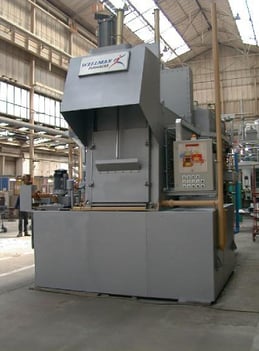Share this
What is a Seal Quench Furnace: Enhancing Metal Component Performance
by Therser UK on 28-Nov-2023 09:35:58
A Seal Quench Furnace, also referred to as a Sealed Quench Furnace, is a highly versatile and essential heat-treating furnace extensively utilized in the manufacturing and processing of diverse metal components. With its primary focus on steel parts, this furnace plays a pivotal role in achieving exceptional mechanical properties and elevating overall performance levels.

The standout characteristic of a Seal Quench Furnace lies in its remarkable capability to swiftly and precisely cool heated metal components, a process commonly referred to as quenching. This furnace boasts a meticulously designed sealed chamber or retort where the parts are carefully positioned for the heat treatment procedure.

The operation of a Seal Quench Furnace follows a well-defined sequence of steps to achieve optimum heat treatment results:
- Loading: Metal components that require heat treatment are carefully placed into the furnace's sealed chamber or retort. Constructed from durable materials like stainless steel, the retort ensures no air or other gases can enter during the process.
- Heating: The furnace is gradually heated to reach the specific temperature needed for the heat treatment procedure. This temperature is typically higher than the steel's transformation point to facilitate the desired metallurgical changes.
- Soaking: Once the desired temperature is attained, the metal parts are held at that precise temperature for a specified duration. This soaking period ensures uniform heating and allows for the intended transformations within the steel to take place effectively.
- Following the soaking phase, the retort containing the heated metal components is swiftly transferred to a specialized quenching chamber. Within this chamber, the parts are exposed to a chosen quenching medium such as oil, polymer, or water. This rapid quenching process effectively cools the parts, resulting in the desired material properties like hardness and toughness.
- Tempering (Optional): In certain instances, after the quenching process, the metal parts may undergo tempering. Tempering involves reheating the parts to a lower temperature, aimed at reducing excessive hardness while simultaneously enhancing toughness, ductility, and dimensional stability.
The utilization of a sealed chamber in Seal Quench Furnaces ensures precise and controlled quenching, minimizing the risk of distortion or cracking in the heat-treated components. Additionally, the selection of the appropriate quenching medium is based on the desired properties and specific requirements of the processed components.
You can also follow this link https://www.therseruk.com/free-guides to our free guide database.
For further details please contact sales@therseruk.com or call 01782 824453 to speak with a sales advisor directly.
Share this
- Company News (78)
- Battery Materials (32)
- kiln (31)
- fabrication (28)
- Furnace (25)
- Alloy (23)
- Industrial Kilns (17)
- Welding (13)
- alloy fabrication (13)
- Ceramic Kilns (12)
- Processes (12)
- RTO’s (12)
- Shuttle Kilns (12)
- Vacancies (11)
- Hydrogen (9)
- Therser UK (9)
- Tunnel Kiln (9)
- Therser (8)
- Wellman Furnaces (8)
- Brickwork (7)
- Case Studies (7)
- Refractory (7)
- Afterburners (6)
- Fibre Lining (6)
- electric (6)
- Almor Wellman (5)
- thermal engineers (5)
- Battery (4)
- Biochar (4)
- Exhibition (4)
- Pyrolysis (4)
- History (3)
- Servicing (3)
- Ceramics Uk (2)
- Combustion Control Upgrades (2)
- Nitrogen (2)
- Spares (2)
- Temperature Control Rings (2)
- gas (2)
- heat treatment (2)
- Certificates (1)
- Instrumentation (1)
- MMC (1)
- RHK (1)
- Roller Hearth Kiln (1)
- Test Trials (1)
- analyser (1)
- elec (1)
- oxygen (1)
- vans (1)
- July 2024 (13)
- June 2024 (2)
- May 2024 (5)
- April 2024 (13)
- March 2024 (8)
- February 2024 (13)
- January 2024 (14)
- December 2023 (6)
- November 2023 (15)
- October 2023 (24)
- September 2023 (11)
- August 2023 (11)
- July 2023 (9)
- June 2023 (15)
- May 2023 (54)
- April 2023 (5)
- March 2023 (6)
- February 2023 (7)
- January 2023 (3)
- December 2022 (8)
- November 2022 (5)
- October 2022 (11)
- September 2022 (1)
- August 2022 (2)
- July 2022 (1)
- June 2022 (2)
- May 2022 (1)
- March 2022 (1)
- February 2022 (1)
- January 2022 (1)
- December 2021 (3)
- October 2021 (1)
- August 2021 (1)
- June 2021 (1)
- May 2021 (4)
- April 2021 (2)
- March 2021 (4)
- February 2021 (2)
- December 2020 (3)
- November 2020 (1)
- September 2020 (3)
- May 2020 (1)
- April 2020 (2)
- March 2020 (1)
- January 2020 (1)
- December 2019 (1)
- July 2019 (2)
- June 2019 (1)
- April 2019 (2)
- March 2019 (3)
- February 2019 (4)
- December 2018 (1)
- November 2018 (1)
- September 2018 (2)
- August 2018 (3)
- July 2018 (2)
- May 2018 (3)
- April 2018 (1)
- February 2018 (3)
- January 2018 (2)
- December 2017 (3)
- November 2017 (1)
- October 2017 (2)
- September 2017 (4)
- August 2017 (1)
- July 2017 (2)
- June 2017 (2)
- May 2017 (3)
- April 2017 (3)

